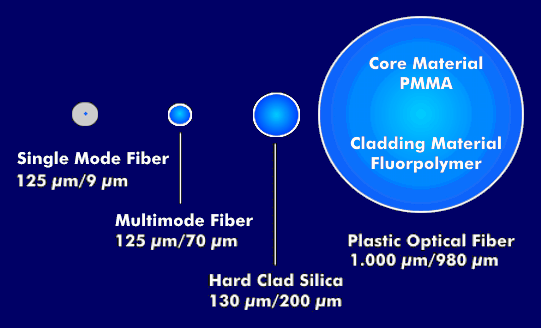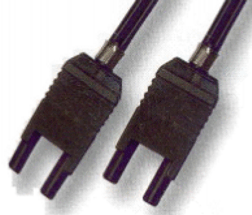plastic optical fiber (POF)
The polymer optical fiber, Plastic Optical Fiber (POF), is an All Plastic Fiber(APF). It consists of a transparent polymeric core glass and a cladding glass, which has a lower refractive index than the core material. A protective cladding of various polymers is applied to the cladding material as required. Compared to optical fiber, POF fiber has much higher attenuation values and a larger diameter, but it is less expensive, easy to install, and, like optical fiber, does not absorb spurious radiation.
Polymer fibers most commonly use polymethyl methacrylate( PMMA) as the core material, sometimes polycarbonate( PC). Core diameters are 980/1,000 µm. The core material of the POF fiber is surrounded by a sheath material of fluorinated acrylate or fluoropolymer that is only 10 µm thin. The most important characteristic values of polymer fibers, such as attenuation and refractive index, which determines the bandwidth, depend on the materials used and the index profiles.
The different POF index profiles
The standard POF fiber has a step index refractive profile(SI-POF). The core diameter is 980 µm, and the cladding diameter is 1,000 µm. The refractive index of the core material is 1.49, that of the cladding 1.41. The difference determines the numerical aperture( NA) and thus the maximum propagation angle. This is about 20 degrees with respect to the fiber axis for a difference of 5%, which leads to a reduction in bandwidth.
SI-POF fibers operate with visible light at wavelengths of 520 nm ( green), 560 nm ( yellow) and 650 nm ( red), mostly using the optical window at the highest frequency. In the green range at 520 nm, data rates of 100 Mbit/s over 300 m are realistic, and in the red range at 650 nm, transmission rates of 50 Mbit/s over 100 m are achieved. Attenuation is 80 dB/km in the green range and 140 dB/km in the red range. The spectral pulse width, specified in half-width, is 20 nm at a wavelength of 650 nm. Since the bandwidth of POF fiber is limited to about 50 MHz, special coding methods are used for high data rate transmission. In the stepped fiber, the light beam is reflected at the cladding material and thus guided within the core material. Since the different modes have different propagation times, shorter light pulses are broadened by material dispersion, which is reflected in the reduction of the bandwidth.
In addition to step fiber( SIF), there are also graded index polymer fibers (GI-POF). In gradient fibers( GIF), the refractive index changes continuously across the cross-section. By reducing the diameter to 500 µm/750 µm or to 120 µm/490 µm and increasing the wavelength to 850 nm, the attenuation of a GI-POF fiber can be reduced to 40 dB/km. With optimal gradient characteristics, GI-POF fibers achieve hundreds of times the bandwidth of SI-POF fibers and have a bandwidth length product of 1.0 GHz x 100 m and data rates of 2.5 Gbit/s over a distance of 200 m at wavelengths of 650 nm. When using laser diodes, the FWHM value is 2 nm.
As an alternative to the step and gradient index, polymer fibers with a multi-step index can be used: Double Step Index (DSI-POF) and Multi Step Index (MSI-POF). DSI-POF fibers can be composed of two layers, MSI-POF fibers of ten or more layers, and have bandwidth length products of 1.5 GHz x 100 m. They are specified by the ATM Forum for ATM at 155 Mbit/s and operate at wavelengths of 525 nm.
Another alternative is multicore POF (MC-POF). In these polymer fibers, the core is divided into many light-carrying regions. The refractive index and numerical aperture are the same as those of the step-index polymer fiber. They have been specified for IEEE 1394. The data rate is 500 Mbps. They are operated with a light emitting diode at 525 nm.
In addition to pure polymer fibers in which the core and cladding are made of plastic, there are fibers in hybrid technology consisting of a combination of core glass and plastic cladding, as in the Plastic Clad Fiber( PCF).
POFs are used for short-distance transmission in automotive and aircraft field buses such as Byteflight, FlexRay and the MOST bus, but also in manufacturing, automation and production, home wiring, computer boards and building automation. Furthermore, it is also used in the connection area with Fiber to the Home( FTTH), in Fiber in the Home( FITH) or in home networks. Polymer fiber has been continuously developed so that it can also be used for broadband applications such as Gigabit Ethernet.
Connectors for polymer fibers
The polymer fibers are connected via POF connectors. There are various versions with and without locking insimplex and duplex design. These include the PN connector, a variant of the F07 connector, the F05 connector from TOSlink, the SMI connector, the HFBR connector, the duplex HFBR according to the HP standard and the RCC-45 connector. The SC connector familiar from wide-area networks is also available with different ferrules for polymer fibers. For space-saving installation in the size of RJ-45 plugs, there are corresponding alternatives in the form of the SC-RJ plug and the EM-RJ plug. The connectors are assembled using various processes. Hot plate is one of these processes in which the plastic fiber is cut and pressed against a hot plate.
Light sources for polymer fibers
Polymer fibers operate in visible light and have their lowest attenuation at about 570 nm. Light-emitting diodes(LEDs), RC LEDs, lasers and VCSEL lasers can be used as light sources. Since LEDs are relatively inefficient and slow at 570 nm, people are switching to more efficient LEDs with lower wavelengths between 450 nm and 530 nm. At higher wavelengths in the 1st optical window, both efficient LEDs as lasers and VCSEL lasers are available.




